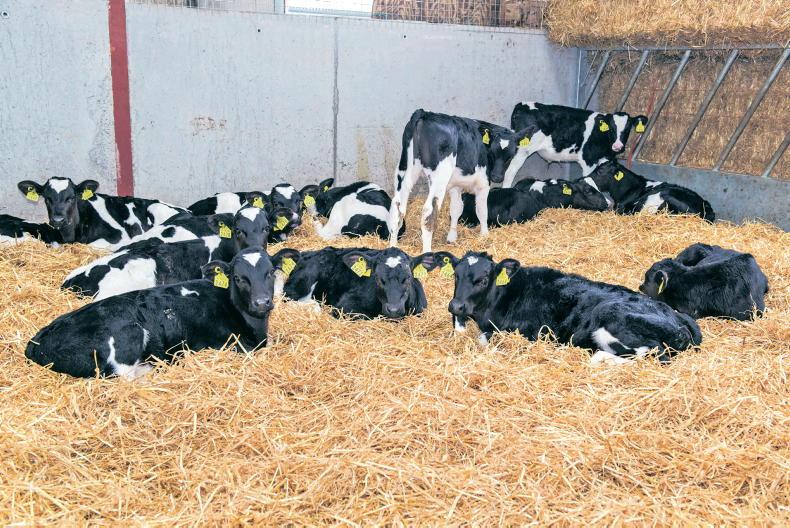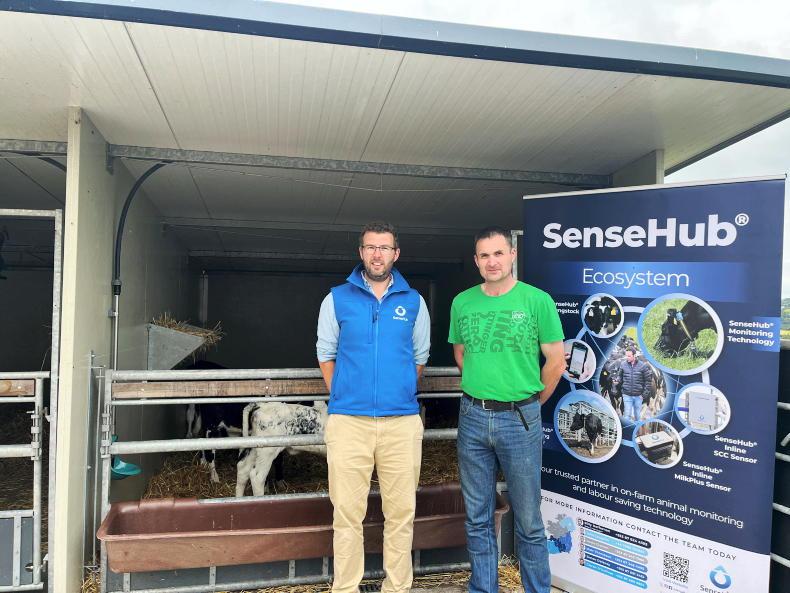Colostrum
The golden rule with calf health is adequate colostrum, or biestings. It remains one of the main factors for calf mortality, according to Department of Agriculture Regional Veterinary Lab (RVL) analysis. This means that of all the calves that die on-farm and are sent to the RVL; insufficient colostrum is a major factor in most deaths, even if the actual cause of death may be some other disease. The thing to remember is that there is only one opportunity to get colostrum right – and that is as soon as possible after birth, ideally within the first two to three hours.
For farmers that buy calves, there is an element of the unknown about colostrum management. If buying farm-to-farm, then colostrum management should be the first question to be asked when looking at calves. If the answer suggests an easy-going attitude towards colostrum, then buyer beware. It’s obviously much harder to do that if buying in the mart. The thing about a lack of colostrum is that calves may look healthy, but because they got insufficient colostrum they won’t have the same level of immunity to disease. So in the event of a disease outbreak, they will be more susceptible.

Feeding colostrum to newborn calves is the best defense against disease.
Adequate feeding
Insufficient feeding will limit calf growth and reduce immunity, thereby limiting the calf’s ability to fight infection or disease. Like babies, calves like consistency when it comes to feeding and and any changes in the diet should be built up gradually over time.
Some changes have to happen instantly, such as moving from twice-a-day feeding to once-a-day feeding, but feeding nuts in the evening time will help with the transition. The key thing is to keep feeding times relatively consistent. Make sure milk replacer is mixed consistently, particularly if different people are doing it and make sure there is enough solids in the mixed milk. In most cases, the mix rate will be between 12.5% and 15% solids.
This means that if feeding 6l of mixed milk replacer at 12.5% solids, then the calf will be getting 750g of powder per day. There is a misconception that too much milk or milk replacer can cause scour, but this is not true and underfeeding is a bigger cause of scour than over-feeding, as the calf will regulate its own intake.
Mix milk replacer correctly
Calculate the total amount of mixed milk that you need. For example, if you are feeding 10 calves 2l of milk, you need 20l of mixed milk in total. If the feeding rate is 12.5% the calves need to get 250g of powder each at each feed, or 2.5kg of powder for the bunch.
Because milk powder will displace water, you should reduce the amount of water used by the quantity of powder. So instead of mixing 2.5kg of powder into 20l of water, you should mix 2.5kg of powder into 17.5l of water to make 20l of mixed milk.
When mixing, pour the correct amount of milk powder into half the desired amount of water and mix with a whisk, or other mixing device. Then add the rest of the water. Never mix with boiling water, as this could corrupt the proteins in the milk replacer. Only ever mix and feed with water at or below body temperature. Milk replacer can be successfully fed cold, although most farmers prefer to feed it warm.

Young calves need a deep bed of straw for adequate heat and comfort.
Adequate bedding
A cold or wet bed will suck the life out of a calf. The ideal air temperature for a calf is between 15°C and 20°C. This is not necessarily the outside air temperature, but the temperature around where the calf lies. A deep bed of straw acts as an insulator or blanket for the calf and increases the temperature if the calf can nestle into the bed. Bedding scores are used by animal health experts to assess the quality of the bedding and the highest score is achieved where the calf’s legs cannot be seen when the calf is lying down, because they are covered by the straw.
The younger the calf, the more important the quality of the bed is, as older calves are stronger and can tolerate more. To increase the temperature in a calf shed, some farmers place infrared heat lamps and others place little canopies by the back wall, which creates a little den for the calves and protects them from overhead draughts, which may be caused by side sheeting in the shed.
Calf jackets are increasing in popularity and many farmers that use them are very happy with them. Where there is already good bedding and good housing they should not be necessary, unless the calf is already challenged for some reason.

Facilities for cleaning calf feeding equipment should be an essential part of a calf shed.
Good hygiene
The challenge when feeding calves is to prevent the build-up of bad bacteria on the surfaces of feeding equipment, such as buckets and teat feeders. Even when feeding equipment looks clean, there can be a build-up of biofilm, which is almost impossible to see with the naked eye, but can harbour bad bacteria.
Keeping equipment clean is a key priority, as dirty equipment will be a breeding ground for bad bacteria, which will end up in the calf’s system and cause challenges, and could lead to scours or other diseases.
Most farmers recognise that this is important, yet many farmers fail to keep equipment clean enough because it’s not easy to do. The lesson here is that if something is easy to do, it’ll be done more often.
Calf sheds should be fitted with hot and cold water taps. If hot water is not currently available, electric or gas heating can be installed.
In most cases, even a cold water tap under high pressure or high volume will be sufficient for keeping equipment clean, followed by weekly deep cleans with warm water. These deep cleans should involve either a chlorine- or caustic-based detergent to remove any hard to move stains that have built up.
Piping hot water should not be used, as this can actually cause biofilms, as the very hot water breaks down the molecules in the milk and causes it to stick to the plastic sides of buckets and feeders.
Feeding equipment should be scrubbed with a brush and after washing it should be rinsed with cold water and then soaked in water containing paracetic acid to prevent bacterial growth.
Some farmers fill old baths or cut the tops off IBC containers and fill with water and paracetic acid solution.
Best policy is to hang feeders and buckets upside down to allow them to dry out before the next feed, as bacteria needs moisture to grow.
In short
Feeding adequate colostrum to newborn calves is the first step in disease prevention. Make sure calves are fed the correct amount of milk or milk replacer, relative to their age and size. Ensure milk replacer is mixed at the correct rates, to prevent under- or over-feeding.A deep bed of straw acts as an insulator or blanket for the calf.
Colostrum
The golden rule with calf health is adequate colostrum, or biestings. It remains one of the main factors for calf mortality, according to Department of Agriculture Regional Veterinary Lab (RVL) analysis. This means that of all the calves that die on-farm and are sent to the RVL; insufficient colostrum is a major factor in most deaths, even if the actual cause of death may be some other disease. The thing to remember is that there is only one opportunity to get colostrum right – and that is as soon as possible after birth, ideally within the first two to three hours.
For farmers that buy calves, there is an element of the unknown about colostrum management. If buying farm-to-farm, then colostrum management should be the first question to be asked when looking at calves. If the answer suggests an easy-going attitude towards colostrum, then buyer beware. It’s obviously much harder to do that if buying in the mart. The thing about a lack of colostrum is that calves may look healthy, but because they got insufficient colostrum they won’t have the same level of immunity to disease. So in the event of a disease outbreak, they will be more susceptible.

Feeding colostrum to newborn calves is the best defense against disease.
Adequate feeding
Insufficient feeding will limit calf growth and reduce immunity, thereby limiting the calf’s ability to fight infection or disease. Like babies, calves like consistency when it comes to feeding and and any changes in the diet should be built up gradually over time.
Some changes have to happen instantly, such as moving from twice-a-day feeding to once-a-day feeding, but feeding nuts in the evening time will help with the transition. The key thing is to keep feeding times relatively consistent. Make sure milk replacer is mixed consistently, particularly if different people are doing it and make sure there is enough solids in the mixed milk. In most cases, the mix rate will be between 12.5% and 15% solids.
This means that if feeding 6l of mixed milk replacer at 12.5% solids, then the calf will be getting 750g of powder per day. There is a misconception that too much milk or milk replacer can cause scour, but this is not true and underfeeding is a bigger cause of scour than over-feeding, as the calf will regulate its own intake.
Mix milk replacer correctly
Calculate the total amount of mixed milk that you need. For example, if you are feeding 10 calves 2l of milk, you need 20l of mixed milk in total. If the feeding rate is 12.5% the calves need to get 250g of powder each at each feed, or 2.5kg of powder for the bunch.
Because milk powder will displace water, you should reduce the amount of water used by the quantity of powder. So instead of mixing 2.5kg of powder into 20l of water, you should mix 2.5kg of powder into 17.5l of water to make 20l of mixed milk.
When mixing, pour the correct amount of milk powder into half the desired amount of water and mix with a whisk, or other mixing device. Then add the rest of the water. Never mix with boiling water, as this could corrupt the proteins in the milk replacer. Only ever mix and feed with water at or below body temperature. Milk replacer can be successfully fed cold, although most farmers prefer to feed it warm.

Young calves need a deep bed of straw for adequate heat and comfort.
Adequate bedding
A cold or wet bed will suck the life out of a calf. The ideal air temperature for a calf is between 15°C and 20°C. This is not necessarily the outside air temperature, but the temperature around where the calf lies. A deep bed of straw acts as an insulator or blanket for the calf and increases the temperature if the calf can nestle into the bed. Bedding scores are used by animal health experts to assess the quality of the bedding and the highest score is achieved where the calf’s legs cannot be seen when the calf is lying down, because they are covered by the straw.
The younger the calf, the more important the quality of the bed is, as older calves are stronger and can tolerate more. To increase the temperature in a calf shed, some farmers place infrared heat lamps and others place little canopies by the back wall, which creates a little den for the calves and protects them from overhead draughts, which may be caused by side sheeting in the shed.
Calf jackets are increasing in popularity and many farmers that use them are very happy with them. Where there is already good bedding and good housing they should not be necessary, unless the calf is already challenged for some reason.

Facilities for cleaning calf feeding equipment should be an essential part of a calf shed.
Good hygiene
The challenge when feeding calves is to prevent the build-up of bad bacteria on the surfaces of feeding equipment, such as buckets and teat feeders. Even when feeding equipment looks clean, there can be a build-up of biofilm, which is almost impossible to see with the naked eye, but can harbour bad bacteria.
Keeping equipment clean is a key priority, as dirty equipment will be a breeding ground for bad bacteria, which will end up in the calf’s system and cause challenges, and could lead to scours or other diseases.
Most farmers recognise that this is important, yet many farmers fail to keep equipment clean enough because it’s not easy to do. The lesson here is that if something is easy to do, it’ll be done more often.
Calf sheds should be fitted with hot and cold water taps. If hot water is not currently available, electric or gas heating can be installed.
In most cases, even a cold water tap under high pressure or high volume will be sufficient for keeping equipment clean, followed by weekly deep cleans with warm water. These deep cleans should involve either a chlorine- or caustic-based detergent to remove any hard to move stains that have built up.
Piping hot water should not be used, as this can actually cause biofilms, as the very hot water breaks down the molecules in the milk and causes it to stick to the plastic sides of buckets and feeders.
Feeding equipment should be scrubbed with a brush and after washing it should be rinsed with cold water and then soaked in water containing paracetic acid to prevent bacterial growth.
Some farmers fill old baths or cut the tops off IBC containers and fill with water and paracetic acid solution.
Best policy is to hang feeders and buckets upside down to allow them to dry out before the next feed, as bacteria needs moisture to grow.
In short
Feeding adequate colostrum to newborn calves is the first step in disease prevention. Make sure calves are fed the correct amount of milk or milk replacer, relative to their age and size. Ensure milk replacer is mixed at the correct rates, to prevent under- or over-feeding.A deep bed of straw acts as an insulator or blanket for the calf. 











SHARING OPTIONS